Website consists of web pages connected with each other to deliver required information. There are many ways to connect pages and we are looking for the best website structure for SEO.
Whether you are starting a new blog or optimizing an existing one with thousands of pages it is good to know which website structure to use. We will evaluate popular website structures used in websites of different sizes.
Website structure will help you organize your existing content, show content gaps and give clear linking guides for future articles. Right website structure will make entry points to your website relevant to search query and rank higher in search results.
Sometimes we will wonder where to link new content or should we write particular content or not. All these doubts will be cleared when you choose website structure.
You will learn:
- What is website structure?
- Types of site structure and their effect on SEO.
- Optimal site structure for SEO.
- Prioritize money earning pages with site structure.
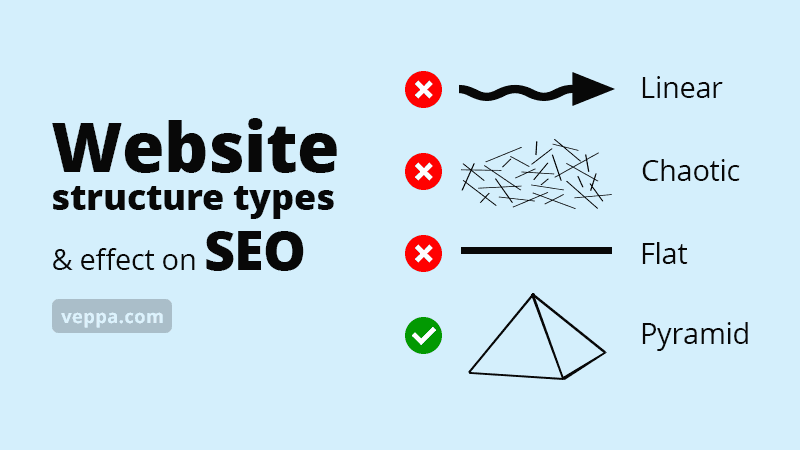
Before comparing website structure types and review their effect on SEO let’s learn more about site structure.
Table of Contents
What is website structure?
Website structure is the way of connecting web pages together with internal links. Connecting pages that are closely related to each other will empower SEO. With the right connections users will spend more time on your website and find related information faster.
Linking to related content and having good user experience is a strong ranking factor for search engines.
This also means using website structure it is possible to increase SEO rank of important pages.
SEO requirements when evaluating website structure
Website structure defines how users and search engines discover content of a website. Web pages are connected to each other with internal links. From an SEO perspective there are some important factors that define the usefulness of website structure.
4 SEO factors (evaluation criteria) that define good website structure:
- Page depth – click distance of web page from home page. Closer your page to the home page shows the importance of the page for search engines. Page depth up to 4th level is considered good.
- Topical relevance – linking to closely related articles is more important than linking to pages for loose relevance.
- Number of incoming links – more incoming links demonstrates the importance of the page.
- Number of outgoing links – every outgoing link passes the value (rank, juice) of the current page. Link value is divided to all outgoing internal and external links from the current page. Pages with few outgoing links will pass more link value to each linked page. Having too many links will weaken (dilute) link value.
These factors should apply to the majority of pages inside good website structure.
Now let’s analyze common website structures and their effect on SEO.
Types of website structure
There are many ways to link web pages together. Most content management systems like WordPress have an automatic linking feature that connects all pages. But most of the time linking pages should be managed manually for better navigation.
There are several types of website structure. Let’s look at each one of them and learn where they are used.
Linear site structure (sequential)
In linear website structure each page links to the next page. Also known as sequential site structure. Usually it is micro sites with 5-10 pages. This structure cannot be effective for websites with hundreds of pages.
Examples of sequential site structure can be: Step by step registration or setup wizard; Education materials where you have to know previous lessons.
Pros:
- Can be used for micro sites.
- Users access new pages after completing previous pages.
Cons:
- Difficult to navigate when used on a website with more than 5 pages.
- Link juice will follow only to the next page.
- Importance of pages cannot be determined by search engines.
- Every page will have only one incoming link.
- Difficult to navigate for users.
- Every next page goes deeper and increases click distance from the home page.
- Not optimized for search engines.
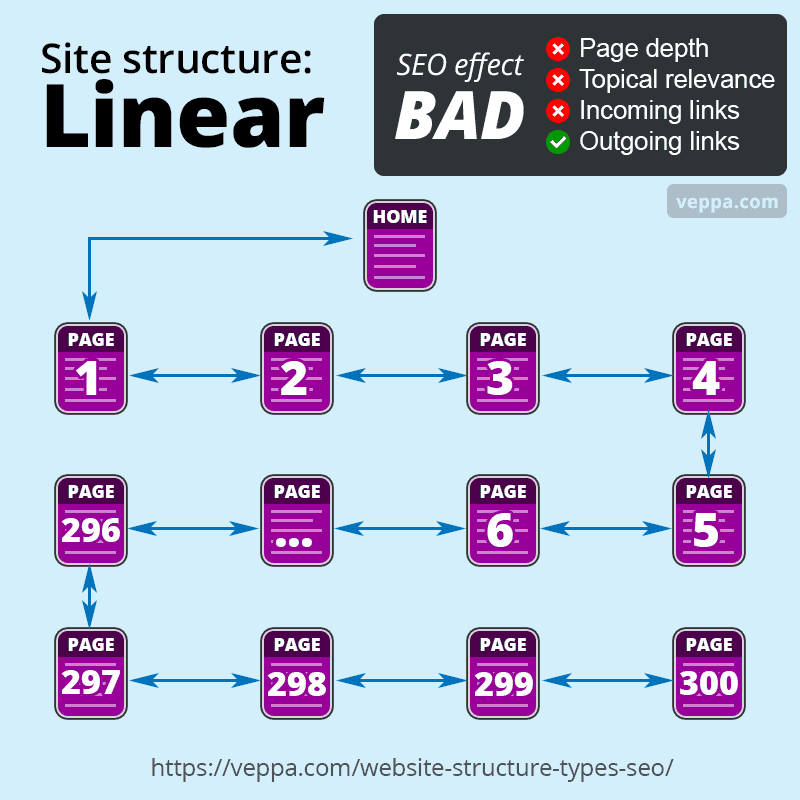
SEO effect (❌ bad):
- Page depth: very bad. There is a single page on each level. If you have 300 pages then the last page will be 300th level. Very bad for SEO.
- Topical relevance: bad. Every page should be linked. This will not guarantee that page will be relevant to every next page.
- Number of incoming links: bad. Only one incoming link from the previous page.
- Number of outgoing links: good. Only one link to the next page.
Conclusion: We can see that this linear site structure is not good for SEO and for users. It is difficult to navigate and find information.
Chaotic site structure (web)
This happens when there is no site structure. Pages are grouped by several taxonomies like author, category, tag, content type, date, month, year, first letter of title etc. Articles can belong to multiple categories. There is no hierarchy. Users can follow their own navigation path.
Pros:
- Chaotic site structures do not need any maintenance.
- It can be built automatically without any effort.
Cons:
- No clean path to follow.
- Difficult to find related articles.
- Unrelated links will harm website SEO.
- Waste of link juice. Pages with no real value will have most of the links.
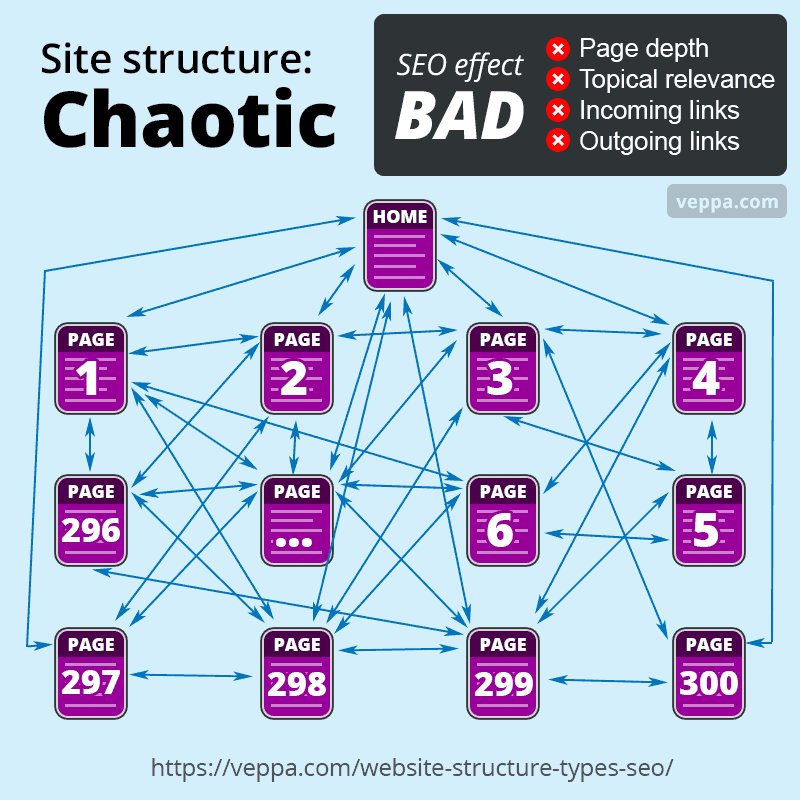
SEO effect (❌ bad):
- Page depth: bad. Having many taxonomies does not guarantee that all pages will be accessible within 4 clicks. It will be very difficult to manage and control page depth because there is no solid structure that covers all pages.
- Topical relevance: very bad. Having too many links going to different pages will not be relevant to all pages.
- Number of incoming links: bad. With chaotic structure you will not have a clear picture of incoming link count. There will be some pages with thousands of links while others with a couple or no link at all.
- Number of outgoing links: bad. Usually having too many irrelevant links lead to chaotic site structure.
Conclusion: We can see that this chaotic site structure is messy. There is no control of which content has higher priority, which content expands the main topic. It is difficult to navigate and not manageable at all.
Flat site structure
Flat site structure is when every page is linked from the home page. Every page has an equal distance from the home page. Can be useful for micro sites.
Pros:
- Can be used for micro sites with 5 pages. As an example it can be a microsite for an event.
- Every page is close to home page (can be accessed with one click from home page)
Cons:
- For niche blog sites with 100-300 posts it is not effective.
- No hierarchy to define important pages is bad for SEO.
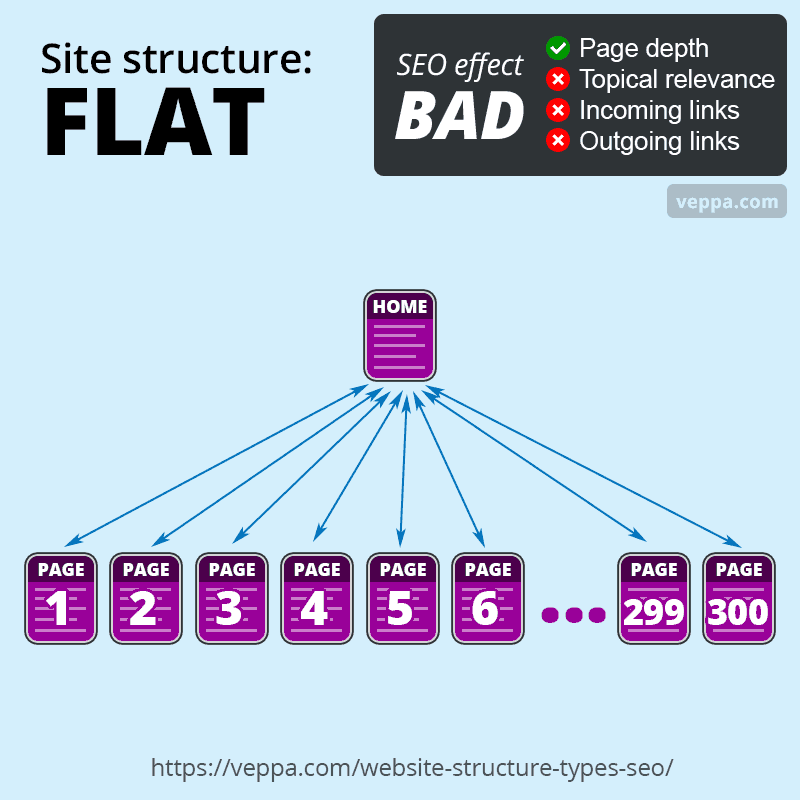
SEO effect (❌ bad):
- Page depth: good. Every page will be one click from the home page.
- Topical relevance: very bad. Pages cannot be relevant to every page on the website. It is difficult to define important pages.
- Number of incoming links: bad. Home page will have links from all pages. Other pages will have only one link.
- Number of outgoing links: bad. Home page will have a link to all pages. This will reduce link value from the home page.
Conclusion: We can see that this chaotic site structure is messy. There is no control of which content has higher priority, which content expands the main topic. It is difficult to navigate and not manageable at all.
Pyramid site structure (hierarchical, tree, silo, hub)
Pyramid site structure also known as hierarchical site structure organizes content with parent child relation. Home page acts as the top of the pyramid and links to 5-10 main topics. Each topic links to 10-20 supporting subtopics. Each sub topic links to 10-20 detailed articles focused with long tail keywords.
In the pyramid site structure each child supports the parent. This way parent topics will get more SEO power and rank higher in search engine results.
Pros:
- Can organize large sites starting from 100-10k pages.
- To cover the maximum number of pages each level can link to 20 pages. In 3 click depth you will have 8k pages (20^3), in 4 click depth 160k pages (20^4).
- Child articles will pass link value to the parent page.
Cons:
- Needs clean structure that can be difficult to organize without a map.
- Need to fill gaps where not enough child pages.
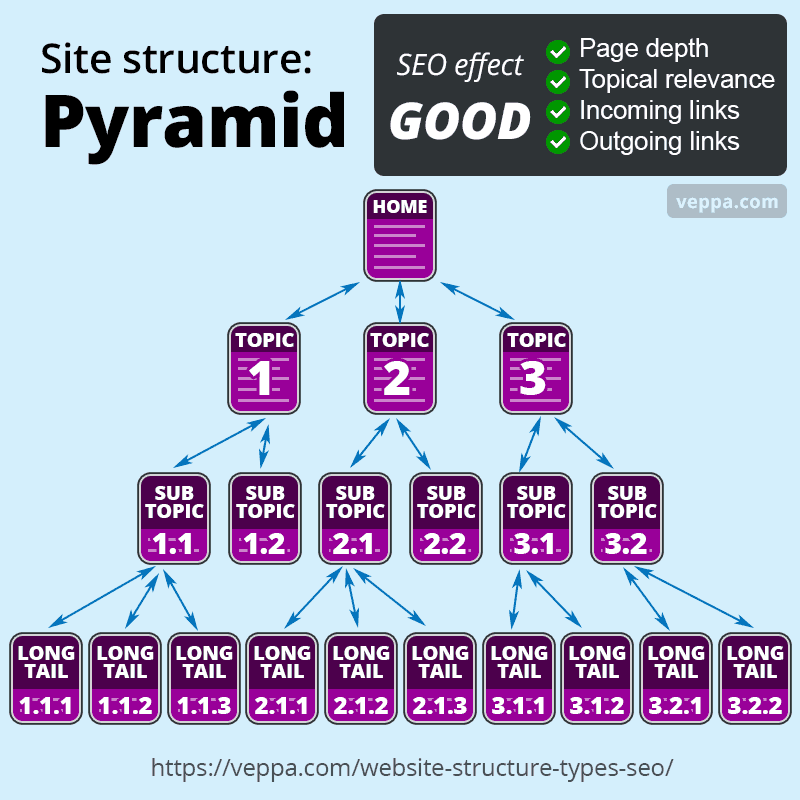
SEO effect (✔ good):
- Page depth: good. Every page will be reached within 4 clicks.
- Topical relevance: good. Every page will link to relevant parent and child pages.
- Number of incoming links: good. Parent pages will get links from all children. This will increase page authority of every parent page.
- Number of outgoing links: good. Links will be to closely related parent and children pages. They are all necessary links and usually less than 20.
Conclusion: We can see that the pyramid site structure is clean and understandable with simple hierarchy. You can map huge sites with pyramid structures. Every parent page will have more authority and pass it to their parents.
What is the best website structure for SEO?
Best website structure from SEO and user perspective is pyramid site architecture. Also known as hierarchical site structure, SEO silos, hub structure, tree structure. Main idea is using the home page as the top of the pyramid. Then add 5-10 main topics. Each main topic is supported by 10 – 20 sub topics as child pages. Each subtopic is further supported by 10-20 long tail articles that complete sub topics.
All links should be contextual. Contextual means that links should be within text surrounded by relevant text. Every page should link only to related pages.
With pyramid site structure you will not have any orphaned pages. Having a single parent will prevent your website from duplicate content.
Articles in pyramid site structure should be organized by keywords. You cannot build powerful pyramid site structure without articles optimized for relevant focus keywords. Building pyramid structure with unrelated articles will not make any sense and cannot provide SEO benefits.
Prioritize money earning pages within site structure
After building the correct pyramid structure you can prioritize important pages by adding links from more relevant pages.
Important pages are those which earn more money. It can be adsense earnings, affiliate earnings, service or product sales.
Pyramid site structure will help to rank chosen 5-10 articles higher showing that they are the most important articles in terms of conversion.
Pyramid website structure also recommended by google for ranking any type of website including e-commerce sites. View this video where this topic is discussed.
Here is a recommendation from google for prioritizing important pages on a website.
FAQ
Why is the structure of a website important?
Website structure helps to determine important pages on your website. Pages supported by relevant child pages that provide additional in depth information on the subject will empower the parent page. With the right website structure your website will get higher topical relevance and get more traffic from search engines.
What structure should your website have?
Best website structure for all types of websites is pyramid site structure. It helps to better rank important pages while getting traffic from multiple long tail articles. Pyramid site structure consists of a home page at the top expanded by main topics. Main topics will expand to multiple sub topics. Each sub topic will further expand to multiple long tail articles.
Can you apply a new website structure to an existing site?
Yes you can change website structure by organizing existing pages to match new website structure. First create site structure offline using any text editor. Organize all pages of your website in hierarchical structure. Then apply that hierarchy to your website by editing related pages, posts and categories. Remove any duplicate pages, unused taxonomies, archives and other pages that break your new website structure. Be careful to not remove pages that already have good organic traffic from search engines.
How to analyze the structure of an existing website?
Existing site structure can be analyzed by Screaming Frog SEO crawler tool. With the free version you can crawl up to 500 pages. It will be sufficient to detect any patterns that break your site structure. Also niche sites generally have around 300-500 pages.
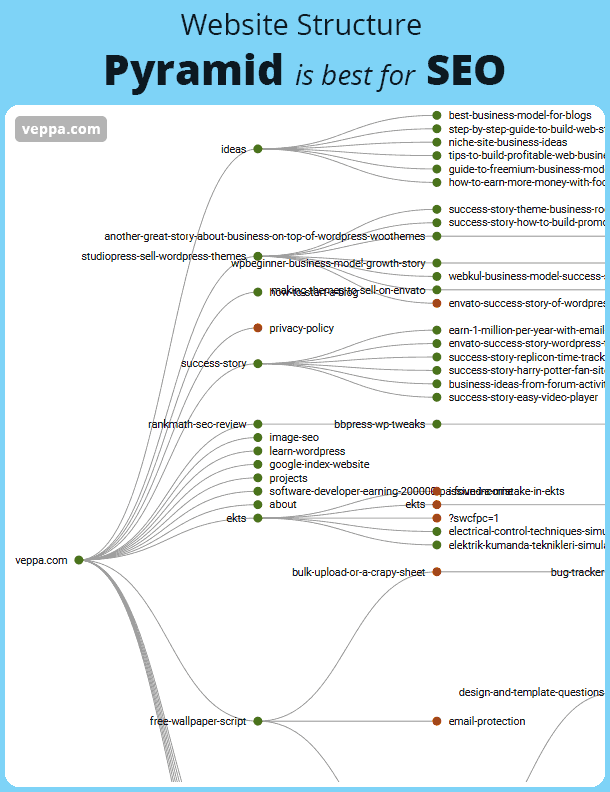
You can also learn how effective your current website structure is by using an internal link report in google search console. There you will see which pages get more incoming links. With the correct pyramid site structure you should see that your main topics get more incoming links. Google search console will allow to view your own websites that are added and verified.
How long does it take to see the effect of website structure change?
You can see the SEO effect when you move from a messy site structure to organized pyramid site structure in 1 to 6 months. When applied correctly and fixed any content gaps you will see an increase in the number of ranking keywords and traffic from search engines.
Conclusion on website structure types from SEO perspective
Website structure is an important part of SEO that cannot be left on autopilot. You need to build a pyramid site structure and stick to it when creating new articles. It will help you organize website content and show you missing content pieces like a puzzle. When you complete those missing articles your website will rank higher and get more visitors.
Make sure not to mess your website structure over time. Review your site architecture and optimize accordingly every 6 months. Learn how to review and apply pyramid site structure in WordPress. You will need to clean up your blog from useless content and links as well.